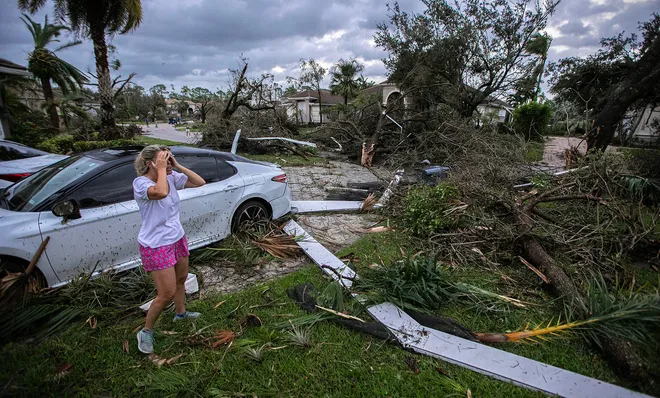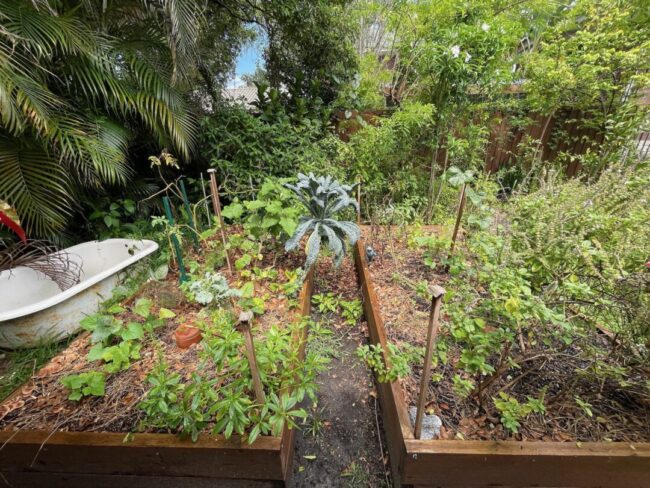
Caring for Florida Native Plants After a Hurricane
What should I do immediately after a hurricane?
At My Dragonfly Gardens, we always recommend beginning with a careful assessment of your garden. Survey your plants for damage such as broken branches or uprooted roots.
- Clear debris: Gently remove fallen leaves and branches to prevent disease and further damage.
- Be patient with pruning: Heavy pruning right away can stress the plants even more. Wait until they show signs of recovery before you prune significantly.
How do I care for flooded plants
Flooding is common in the aftermath of storms.
- Ensure proper drainage: Native plants thrive when their roots can breathe. Check for standing water and, if needed, create pathways for drainage.
- Loosen compacted soil: Carefully aerate the soil around the plant base to encourage root recovery.
- Hold off on fertilizers: Stressed plants are sensitive. Avoid fertilizing until your plants start to show new growth.
My trees are leaning; should I prop them up?
Our Florida native trees can often recover from leaning, but here's what to do:
- Check root stability: If a tree is only slightly tilted, it may right itself naturally. Larger trees may require bracing or staking.
- Reposition with care: For trees that have been uprooted but have intact roots, gently reposition and stake. Don’t forget to cover exposed roots with soil and to water deeply to help the roots re-establish.
- For larger trees, anything you cannot handle, we recommend hiring a professional.
How should I handle broken branches?
At My Dragonfly Gardens, we suggest using clean, sharp tools for this step:
- Trim damaged branches: Make precise cuts just outside the branch collar for the best chance of recovery.
- Leave minor damage: Minor damage will often heal on its own, as your resilient native plants recover.
Will my Florida native plants recover?
Rest assured that native plants are built to withstand Florida’s storms. Many plants will recover with time.
- Watch for new growth: This is the best indicator of a plant’s recovery. If you don’t see any after several months, it may be time to replant.
Should I fertilize after a hurricane?
Although Florida native plants do not need fertilization, if you do we recommend giving your plants a break:
- Hold off on fertilizers: After a storm, it’s best to wait until your plants start recovering on their own before introducing any fertilizers.
Hurrican Milton's Damage
Palm Beach County, as reported by The Palm Beach Post - Oct. 10, 2024


How can I prevent future hurricane damage?
- Use native plants: Native species are better equipped to handle Florida's hurricanes.
- Mulch wisely: Keep mulch away from the base of trees and plants for better drainage and root health.
- Prune regularly: Strategic pruning of weak branches can prevent breakage during storms.
How do I care for salt-damaged plants?
Hurricanes can bring salt spray that can harm your garden:
- Rinse leaves with fresh water: Remove any salt buildup from plant leaves.
- Flush the soil: Water deeply to help leach the salt out of the soil and protect your plants’ roots.
Should I replant immediately?
Our advice at My Dragonfly Gardens is to wait until the soil has settled. Rushing to replant may cause more harm than good. Let the soil dry out and stabilize before introducing new plants.
What if my plants are slow to recover?
Patience is key. Many Florida natives are slow to show signs of life after extreme stress. At My Dragonfly Gardens, we believe in letting nature take its course and encouraging recovery before taking drastic measures.
The following question came from user like you!
How should I care for wind-burned plants?
Wind damage from hurricanes can cause leaves to dry out and appear scorched:
- Prune only if necessary: Trim away leaves and branches that are severely damaged. However, if there’s minimal damage, let the plant recover naturally.
- Hydrate the plants: Wind can dry out the soil quickly, so ensure your plants are getting enough water post-storm.
What if the roots of my plants are exposed?
Sometimes hurricanes can wash away soil, leaving plant roots exposed:
- Re-cover exposed roots: Gently cover the exposed roots with soil or mulch to protect them from further damage.
- Water consistently: Keep the soil moist to help roots re-establish underground.
Can I save a tree that’s been uprooted?
A partially uprooted tree can often be saved with the right steps:
- Replant the tree quickly: The sooner you can replant an uprooted tree, the better its chances for survival.
- Stake the tree for stability: Use stakes or ropes to secure the tree and support its growth until its roots re-establish.
- Water deeply: Water the tree thoroughly after replanting to help settle the soil and encourage root recovery.
The same may apply to large trees, yet we recommend hiring the help of an Arborist.
How can I prevent fungal diseases after a storm?
The wet conditions after a hurricane can create the perfect environment for fungi:
- Remove debris quickly: Clearing away fallen leaves and branches can help reduce the chance of fungal growth.
- Improve airflow: If neessary, thin out crowded plants to allow for better air circulation and prevent mold and mildew.
How do I care for newly planted natives after a hurricane?
Young plants are more vulnerable to storm damage:
- Check for uprooting: Ensure newly planted natives are still firmly in the soil. Replant and stake them if necessary.
- Water wisely: Too much or too little water can stress new plants, so keep an eye on moisture levels.
- Protect with mulch: Apply mulch around the base (but not touching the stem) to regulate soil moisture and temperature.
Can saltwater damage my soil?
In coastal areas, saltwater intrusion can harm your garden:
- Flush with fresh water: If your soil has been exposed to saltwater, you could try to deeply water the area (if sandy soil) to wash the salt out of the root zone.
- Test your soil: If you're concerned about salt levels, a soil test can help determine if any remediation is needed.
Should I replace mulch after a hurricane?
Mulch is important for protecting your plants, but hurricanes can scatter it:
- Reapply or redistribute: If mulch has washed away or become uneven, rake it back into place or add fresh mulch to maintain proper coverage.
- Use natural mulch: Organic mulches like pine straw, pine bark or leaves help retain moisture and regulate temperature after a storm.
How can I prepare my garden for future hurricanes?
Preparation is key to minimizing damage (also see “How can I prevent future hurricane damage?” above):
- Select wind-resistant plants: When planning your garden, choose native plants known for their wind resistance. Contact My Dragonfly Gardens for a list of the most common.
- Plant strategically: Place taller, more vulnerable plants away from wind tunnels or secure them with stakes. A redesign may be helpful.
- Keep a regular maintenance schedule: Pruning, mulching, and monitoring plant health regularly will ensure your garden is better equipped for storms. We also offer garden maintenance services if you need help.
At My Dragonfly Gardens, we specialize in creating resilient, sustainable landscapes that thrive in Florida’s unique climate. For more personalized advice or to learn more about caring for your native plants, follow us on Facebook, Instragram and LinkedIn, or contact us directly at 1(833) 353-4323 or DM at our contact page.
Please comment or ask questions below
If we don’t know the answer, one of our featuer partners should.





